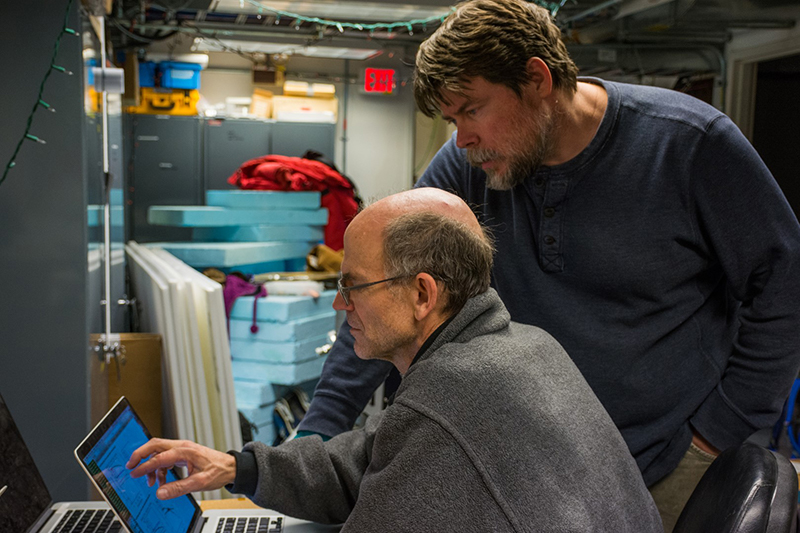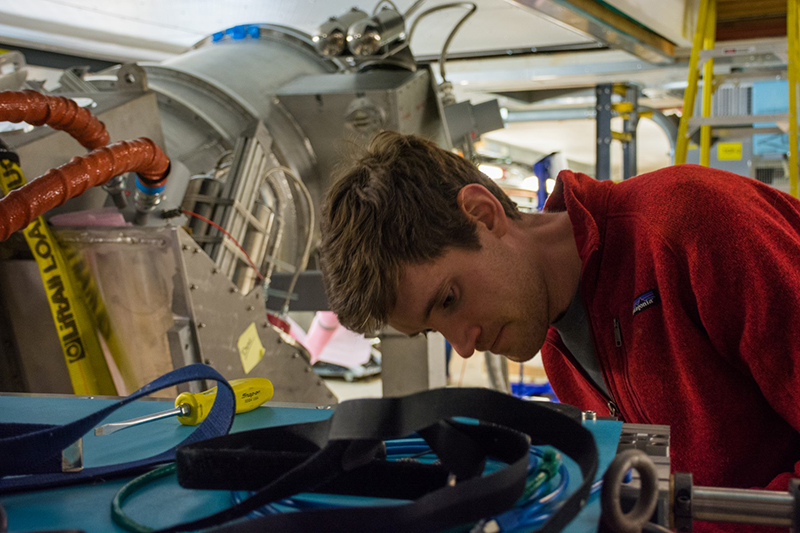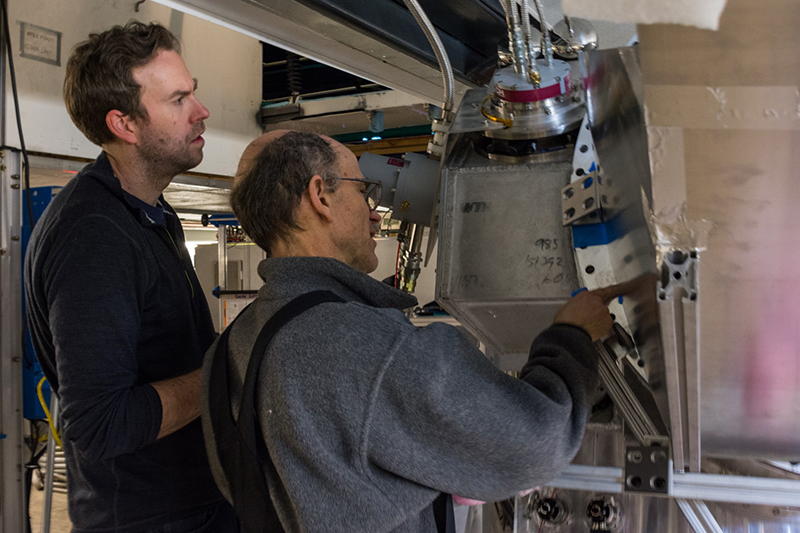The South Pole Telescope’s New EyesNew detectors dramatically increase the South Pole Telescope's sensitivityPosted December 19, 2017
The telescope at the bottom of the planet spent winter calibrating and collecting data after its vision enhancement last summer. 
Photo Credit: Mike Lucibella
The SPT’s new detector and cryostat wait to be installed inside the telescope’s instrumentation bay, located just below its large reflective dish.
Researchers installed a new camera system in the South Pole Telescope, a major upgrade that let the researchers collect more data than before. The team increased the total number of digital pixels on the telescope’s light sensor, and gave each one the ability to see multiple types of light. This new detector is altogether about ten times as powerful as the last one. “We’re going from 1,600 pixels to almost 3,000 pixels,” said John Carlstrom, of the University of Chicago and principal investigator on the project. “Each pixel now will have six detectors, three differ colors, two different polarizations. So it’s an order of magnitude increase in the camera.” 
Photo Credit: Mike Lucibella
John Carlstrom (left) and Erik Nichols look over data from the South Pole Telescope during the installation of its new detector.
The project is supported by the National Science Foundation (NSF), which manages the U.S. Antarctic Program. The telescope’s detectors act like a light sensor inside a digital camera. In a camera, an image is created when incoming light gets focused by the lens and hits the digital sensor, converting it into a digital signal. In the South Pole Telescope, light in the form of microwaves are focused by the 10-meter reflecting dish outside onto the detectors, which then convert it into a digital signal and ultimately an image of the night sky. “This [detector] is really the heart of the entire instrument,” said James Sayre, a postdoctoral student at the University of Colorado, Boulder. “Everything else is built and designed in order to get light basically to this.” In addition the detector, its surrounding cryostat was also replaced. The refrigerator-sized assembly was loaded into the telescope’s instrument bay at the base of its 10-meter dish. The cryostat keeps the detectors at a constant temperature a tiny fraction of a degree above absolute zero. This is because the universe is very cold, about three degrees above absolute zero, and the detectors need to be colder than that in order for the signal not to be lost in the detector’s own heat signature. The research team is using the telescope to map the most distant edges of the visible universe. It’s building on work they’ve done over the past decade with previous iterations of the telescope’s camera. 
Photo Credit: Mike Lucibella
The telescope's old detector sits on a table after it was removed from the instrument. The new one is bigger and packed with more digital sensors that can also detect different colors and polarizations of light.
“We spent four years on the same part of the sky, observing, scanning, back and forth, over and over again to make that image,” Carlstrom said. “We’ll go deeper on same part of the sky, and enlarge it by about a factor of five, but with the new telescope it will go about 20 times faster. So what we did in four years, we can reproduce and go beyond that in about a month or so.” Instead of visible light, the telescope is tuned to detect microwaves, light with wavelengths one thousand times longer than what the human eye can see. The best place on the planet to observe these cosmic microwaves is at the South Pole. Its arid climate, frigid temperatures and more than one and a half miles of altitude combine to make the surrounding air so thin and dry, it’s almost completely transparent for these light waves. “If you think of microwave ovens, you use them to heat up water. So water absorbs microwaves and it also emits radiation in microwaves,” Carlstrom said. “So we want to go to a site where there’s very little water vapor, and it turns out that the South Pole is like the driest desert on Earth for that.” With no cities for thousands of miles, there’s also almost no light pollution to interfere with observing the sky. Plus, for six months of the year, the brightest source of microwaves in the sky, the sun, is below the horizon with its interference obscured by planet Earth. The researchers are focusing the telescope on microwaves emitted by the Cosmic Microwave Background, or CMB. It’s light at the very edge of the visible universe left over from before there were galaxies, stars or even atoms. This light has taken 13.8 billion years to cross the cosmos and reach planet Earth. 
Photo Credit: Mike Lucibella
Adam Anderson makes an adjustment to one of the telescope's many cables that carry information from its detector to the hard drives where data is stored.
For the first 380,000 years after the Big Bang, the cosmos was so hot and dense that light couldn’t penetrate the miasma of ionized plasma, making it completely opaque. As the universe expanded, it cooled, allowing much of that energy to coalesce into matter like electrons and protons. In the process, the universe became transparent for the first time. The cosmic microwave background is a snapshot of that transition, the first time the universe was clear enough for light to travel meaningful distances. As the universe continued to expand, the light waves from that transition stretched out. Now, instead of bright visible light, the waves elongated to become microwaves. Scientists are looking for subtle variations in the way the light waves in the CMB are oriented, or it’s polarization. They’re trying to see faint swirling patterns in it, imprints left over from an even earlier time in the universe. That signal is hard to see because the CMB is so consistent and smooth across the sky. “It is extremely uniform,” said Bradford Benson, an astrophysicist at the University of Chicago. “We’re looking for faint variations in the polarization of that light, at a level of basically one part in ten million.” 
Photo Credit: Mike Lucibella
Matt Dobbs (left) and Amy Bender inspect the cables that carry the data from the telescope's detector to the hard drives that store the collected data.
It’s not easy to detect such a faint signal, but the research team used some impressive engineering to make their instruments as sensitive as possible. “The measurements that we’re trying to do are extremely precise,” said Benson. “To do that, we have to cool the detectors to a quarter of a degree above absolute zero.” The detectors have to be kept at such cold temperatures inside of its cryostat because in effect they act as incredibly sensitive thermometers. Each photon of incoming light carries a tiny amount of energy that the pixels in the telescope can detect. “Basically that light is converted into heat,” Benson said. “If there’s a little more microwave light, or bright heat coming from the sky in a certain location, it will heat up the detector, only fractions of a degree above absolute zero. We’ll sense that heat. It’ll change the resistance of this thermometer, which we measure as a change in voltage in that direction on the sky.” 
Photo Credit: Mike Lucibella
Brad Benson (left) and John Carlstrom inspect the casing surrounding the telescopes soon-to-be-installed cryostat and detector.
These detectors are so sensitive that the telescope’s circuitry has to be specially designed to make sure that its own wiring isn’t interfering with any incoming signal. “They can pick up absolutely anything,” said Matthew Dobbs, a cosmologist at Canada’s McGill University. “So one of the big challenges is keeping the interference, the bad signals that’re created by [the circuit] board’s operation out of what’s happening inside the cryostat.” Even the metal wires that carry the digital signal could conduct heat onto the detectors that are cooled to nearly absolute zero, causing interference. “You can’t attach a wire to every single one of your detectors, so you have to be clever,” said Jessica Avva, a graduate student at the University of California, Berkeley. “You attach a few wires instead of a lot and each detector we put in circuits so their data is at a different frequency.” The telescope’s central computer disentangles these signals akin to how a car’s radio antenna can pick up just a single radio channel at a time. After that the raw data is sent over satellite to the researchers’ home institutions where it’s cleaned up and refined and turned into detailed maps of the Cosmic Microwave Background. The newly upgraded South Pole telescope began taking data as soon as the sun set in March. The equipment worked well over the six months of darkness, and the team collected information about the cosmic microwave background. It’s just the beginning of the multi-year run to probe the ancient universe and try and glean more insight into some of the deep questions of the cosmos. “I think that everyone asks at some point, ‘How did we get here? What is out there? What is the origin? What are the laws of physics, and the fundamental workings of the universe?’ and that’s what we’re probing,” Carlstrom said. NSF-funded research in this story: John Carlstrom, University of Chicago, Award No. 1248097. |



For USAP Participants |
For The Public |
For Researchers and EducatorsContact UsU.S. National Science FoundationOffice of Polar Programs Geosciences Directorate 2415 Eisenhower Avenue, Suite W7100 Alexandria, VA 22314 Sign up for the NSF Office of Polar Programs newsletter and events. Feedback Form |


